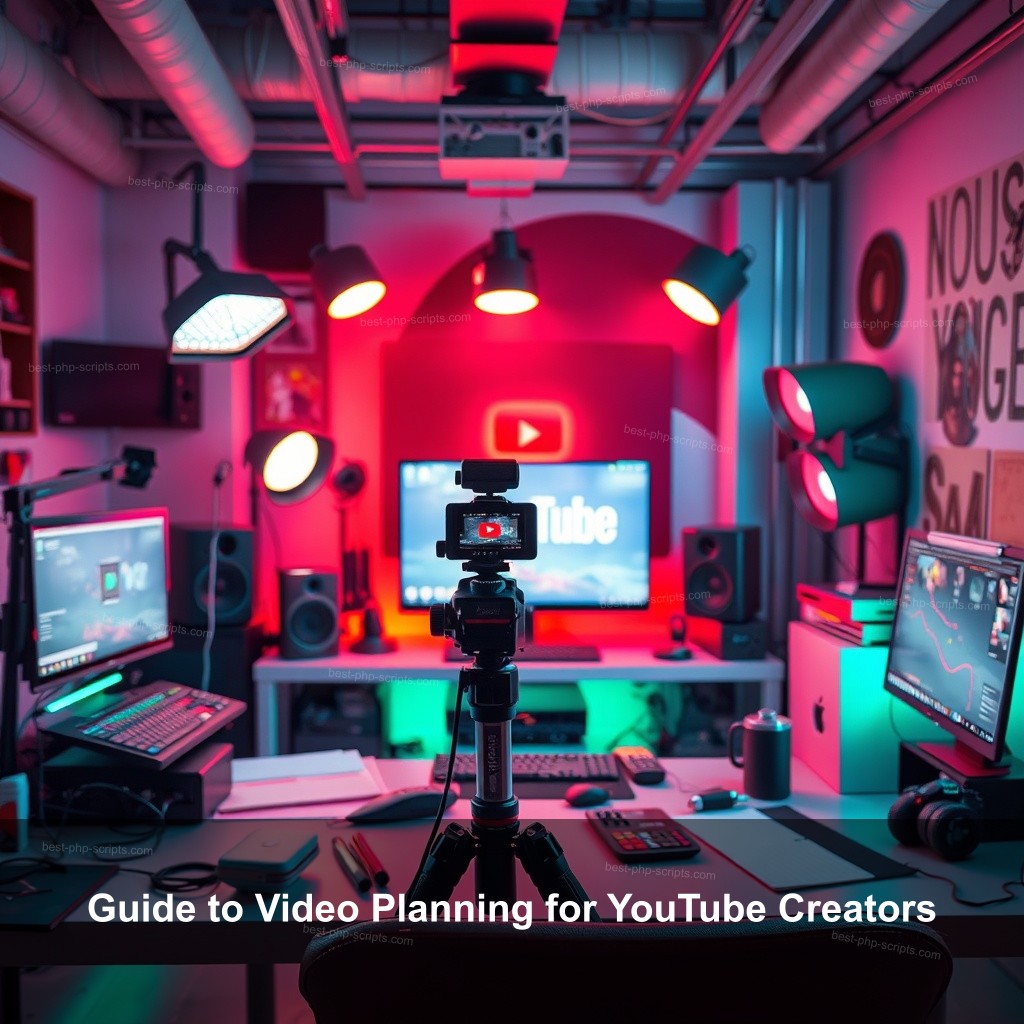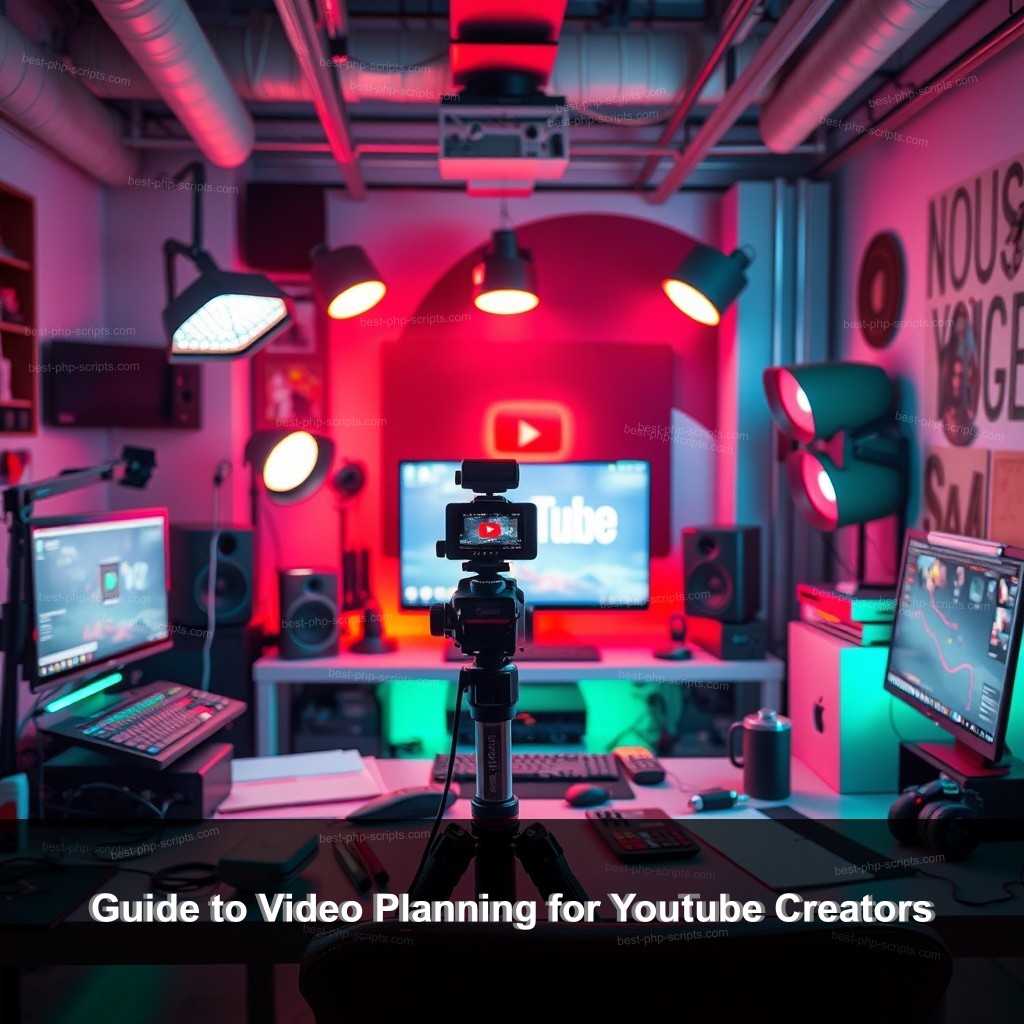Did you know that effective video planning can significantly boost your engagement and growth on YouTube? In this guide, we will explore various aspects of video planning for creators. Whether you’re just starting or looking to refine your strategy, this post will cover essential tips and techniques for content planning and video scheduling. You’ll learn how to create engaging content that resonates with your audience and keeps them coming back for more. Join us as we look into the world of video planning!

Guide to Video Planning for YouTube Creators
Every successful YouTube channel starts with a solid plan. Content planning is key to creating videos that not only attract viewers but also keep them engaged. Begin by defining your audience. Understanding who you are creating content for will help shape your video ideas and formats. Use tools like Google Analytics or YouTube Analytics to gather insights about your viewers’ demographics and interests.
Then set definite objectives for your videos. With every bit of material, what do you hope to accomplish? Whether your goals are raising brand awareness, boosting website traffic, or expanding your subscriber base, defining particular objectives will provide you guidance. Finally, evaluate your current assets. This covers your staff, tools, and financial plan. Knowing your resources will guide your planning process and enable you to set priorities for jobs.
| Resource Type | Description | Examples |
|---|---|---|
| Budget | Money allocated for video creation | Camera equipment, Editing software |
| Tools | Software or hardware used in production | Microphones, Lighting setups |
| Team | People involved in the creation process | Editors, Scriptwriters |
For a more detailed look at video content, check out our Guide to Video Content Creation.
Understanding Content Planning
Content planning is crucial for any creator. It allows you to streamline your workflow and ensure consistent uploads. One effective way to manage your content is by creating a detailed content calendar. A content calendar helps you visualize your schedule and plan themes around seasonal trends or events.
Here’s how to create one:
- Identify key dates: Mark important events and holidays relevant to your content.
- Choose your content types: Decide on the types of videos you will create, such as tutorials, vlogs, or interviews.
- Distribute your workload: Spread out your filming and editing tasks to avoid burnout.
Consider involving your audience in the content creation process. Ask them what they would like to see more of. This not only helps with engagement but also ensures you are meeting their interests. The feedback loop can be an excellent way to refine your strategy.
For example, if you notice that viewers respond positively to behind-the-scenes content, perhaps you should consider incorporating more of that into your schedule.
For more insights into effective strategies, explore our Explore Growth Strategies.
Effective Video Planning Strategies
Planning your videos effectively can make a world of difference. Start by researching trending topics in your niche. Use tools like Google Trends or social media insights to identify what your audience is interested in right now. This ensures your content remains relevant and engaging.
Next, outline your video structure. This involves breaking down the content into segments to maintain clarity and flow. For instance, you might start with an introduction, followed by the main content, and conclude with a call to action.
Furthermore, incorporate SEO practices into your planning. Optimize video titles, descriptions, and tags with relevant keywords. This will improve your visibility in search results and attract more viewers. For best marketing practices, refer to our Best Marketing Practices for Videos.

Long-tail Keywords for Video Content Planning
Utilizing long-tail keywords is important for targeting niche audiences effectively. Phrases like “how to plan YouTube content effectively” and “creating a video content schedule” can help you reach viewers looking for specific guidance.
Sort material first around these keywords. Under “how to plan YouTube content effectively,” for instance, you may offer a detailed walk-through tutorial for delineating video ideas. Add pointers for evaluating the possible influence of the video and for brainstorming.
How to Plan YouTube Content Effectively
Good planning for YouTube video begins with investigating popular subjects. Find what’s hot in your niche with Google Trends. This will enable you produce something your readers will find interesting.
Next, outline your video structure. A clear outline will keep you organized and ensure you cover all essential points. Also, schedule regular uploads to maintain audience interest. Consistency in posting builds trust and keeps viewers engaged.
Another aspect is to keep track of your video performance. Analyze which videos perform well and what topics seem to attract more viewers. This information can guide your future content creation and refine your planning strategy.
Creating a Video Content Schedule
Creating a video content schedule is vital for staying on track. Set realistic deadlines for each phase of production, including scripting, filming, and editing. Use project management tools like Trello or Asana to track tasks and ensure accountability.
Check your development also often. Change your calendar in response to viewer comments and performance data. The fast-paced industry of content development depends mostly on flexibility.
For more on video effects, check our guide on How to Add Video Effects.
Best Practices for Content Planning
Implementing best practices in content planning can elevate your video strategy. Start by setting clear objectives for each video. Understand what success looks like for you—be it views, engagement, or subscriber growth. This will guide your content decisions.
Study the approaches of your rivals. Find out what works for them and modify those approaches to suit your style. Keep quality over quantity; creating less frequent, high-quality content can produce better results than regular, substandard uploads.
Strategic Planning Techniques
Strategic planning techniques are key for long-term success. Outline key milestones in your production journey. This includes everything from content ideation to post-production evaluation. Milestones help keep your team focused and accountable.
Match your material also with seasonal trends. Scheduling around holidays or events will help to raise relevancy and viewer interest. Make themed movies for holidays your audience will find meaningful, for instance.
Content Roadmap Development
Creating a content plan gives your clear view of the direction your material will go. Decide on important subjects and content kinds you wish to investigate. This helps to preserve a coherent approach fit for the interests of your audience.
Be prepared to adjust your roadmap based on audience feedback and performance data. Regular reviews of your content’s effectiveness will keep you on the right track and help you make informed decisions.
Additional Resources for Video Planning
Think about using several tools and apps to help with your video planning. Popular video editing programs like Final Cut Pro or Adobe Premiere Pro can raise the caliber of your output. Look at choices within your means and degree of expertise.
Moreover, content management systems can help organize and distribute your videos efficiently. Use platforms that allow easy access to your work and collaboration with team members.
Tools and Software Recommendations
For video producers nowadays, there are several tools at hand. For editing, Camtasia provides strong capabilities together with easy interfaces. Asana is great for keeping project management tasks and deadlines under control.
Analytics tools like Google Analytics or YouTube Analytics are crucial for tracking your performance. They provide insights on viewer behavior and help you refine your content strategy.
Engaging with Your Audience
Building a committed community depends on interacting with your audience. Respond to comments and encourage viewer remarks to inspire conversation. This makes one feel like they belong and motivates returning viewing.
Utilize social media platforms for promotion. Sharing snippets of your videos can draw viewers to your main content. Collaborate with other creators to tap into their audiences and expand your reach.
FAQ
What are the key elements of video planning?
The key elements include defining your audience, setting clear goals, assessing available resources, and creating a content calendar.
How can I create a video content schedule?
Create a schedule by setting realistic deadlines, utilizing project management tools, and regularly monitoring your progress.
Why is strategic planning important for YouTube creators?
Strategic planning helps creators align their content with audience interests, maintain consistency, and achieve long-term success.
What tools can help with video planning?
Tools like Adobe Premiere Pro for editing, Trello for task management, and Google Analytics for performance tracking are highly recommended.
How often should I post videos?
Consistency is key. Aim for a regular posting schedule that suits your capabilities, whether that’s weekly, bi-weekly, or monthly.
Conclusion
In summary, effective video planning can dramatically improve your YouTube strategy. By focusing on content planning, utilizing tools, and engaging your audience, you can elevate your channel’s performance. Share your thoughts in the comments below and explore more resources on Best PHP Scripts.

Leave a Reply